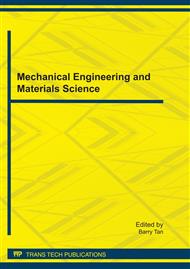[1]
Mizuno O & Noike T (1998) The behavior of sulfate-reducing bacteria in acidogenic phase of anaerobic digestion, Water Res. 32(5), 1626~1634.
DOI: 10.1016/s0043-1354(97)00372-2
Google Scholar
[2]
Singh R(2010) Removal of sulphate, COD and Cr(VI) in simulated and real wastewater by sulphate reducing bacteria enrichment in small bioreactor and FTIR study. Bioresource Technology. Available online 24 August (2010).
DOI: 10.1016/j.biortech.2010.08.041
Google Scholar
[3]
Czako L (1988) Biological Sulfate Removal in the Acidic Phase of Anaerobic Digestion, Fifth International symposium on Anaerobic Digestion (Poster Papers), Bologna, Italy. 833~837.
Google Scholar
[4]
Reise MA (1988) Sulfate Reduction in Acidogenic Phase Anaerobic Digestion, Proc. Int. Conf. on Water and Wastewater, Microbiol, Cam USA. 58, 1~7.
Google Scholar
[5]
Sarner E (1988) The ANTRIC Filter-A Novel Process for Sulphur Removal and Recovery. Fifth International Symposium on Anaerobic Digestion (Poster Papers), Bologna, Italy, 889~892.
Google Scholar
[6]
Gao Y (1989) Anaerobic Digestion of High Strength Wastewaters containing High Levels of sulfate. Ph.D. Thesis, Univ. of Newcastle upon Tyne, England.
Google Scholar
[7]
Zuo J & Hu J (1996) Anaerobic treatment of sulfate organic wastewater. Environmental Science, 3: 69 (in Chinese).
Google Scholar
[8]
Li Y X & Su BQ (2000) Sulfate-reducing bacteria and acid mine wastewater bio-treatment. Environmental pollution control technology. 1(5): 1-11 (In Chinese).
Google Scholar
[9]
Wang AJ, Ren NQ & Liu W (2001) The ecological role of SRB population in acidogenic de-sulfate bioreactor. Chinese Environmental Science. 21 (2): 119~123 (in Chinese).
Google Scholar
[10]
Browning B. J(2010) Succession of mosses, liverworts and ferns on coarse woody debris, in relation to forest age and log decay in Tasmanian wet eucalypt forest. Forest Ecology and Management. 260 (10): 1896~(1905).
DOI: 10.1016/j.foreco.2010.08.038
Google Scholar
[11]
Okabe S (1999) Microbial ecology of Sulfate-Reducing Bacteria in wastewater bio-films analyzed by microelectrodes and FISH (fluorescent in situ hybridization) technique. Wat. Sci. & Tech. 39(7), 41-47.
DOI: 10.2166/wst.1999.0323
Google Scholar
[12]
Hwang J H(2009) Effect of COD/ SO42-ratio and Fe(II) under the variable hydraulic retention time (HRT) on fermentative hydrogen production. Water Research. 43 (14): 3525~3533.
DOI: 10.1016/j.watres.2009.04.023
Google Scholar
[13]
Ji B & Zhang F (1999) The advance of anaerobic treatment technique for high strength sulfate wastewater. China methane. 17(3), 3 (in Chinese).
Google Scholar
[14]
Wang, A. J. The ecology of SRB in acidogenic de-sulfate reactor—forming of climax community and controlling of ecological factors. Ph.D. Dissertation paper of Harbin institute of Technology. 2000 (in chinses).
Google Scholar
[15]
Zhu J Q(2010) Sulfate-reducing bacteria in a denitrification reactor packed with wood as a carbon source. Bioresource Technology. Available online 12 October (2010).
DOI: 10.1016/j.biortech.2010.10.015
Google Scholar
[16]
Lin H R(2010) Effects of lead upon the actions of sulfate-reducing bacteria in the rice rhizosphere. Soil Biology and Biochemistry, 42(7): 1038~1044.
DOI: 10.1016/j.soilbio.2010.02.023
Google Scholar
[17]
Barton L L (1995) Sulfate-Reducing Bacteria. Plenum Press, New York and London. 294~303.
Google Scholar
[18]
APHA (1995) American Public Health Association, Standards Methods for the Examination of Water and Wastewater, 19th ed., Washington D. C.
Google Scholar
[19]
Ren NQ, Wang B & Huang J (1997) Ethanol-type fermentation from carbonhydrate in high rate acidogenic reactor. Biotechnology and Bioengineering. 54(5): 428-433 (in Chinese).
DOI: 10.1002/(sici)1097-0290(19970605)54:5<428::aid-bit3>3.0.co;2-g
Google Scholar
[20]
Truper HG. & Schlegel HG (1964) Sulphur metabolism in Thiorhodaceae1quantitative measurements on growing cells of Chromatium okenii. Antonie van Leeuwenhoek 30, 225~238.
DOI: 10.1007/bf02046728
Google Scholar
[21]
Lin M, Ren NQ & Wang AJ (2003) Cooperation of mixed culturing bacteria in the hydrogen production by fermentation. Environmental Science. 24 (2): 54-59 (In Chinese).
Google Scholar
[22]
SY/T 0532-93 (1993) Disappearing dilution technique, an oil field water-infusing bacteria analytical method of petroleum and natural gas standard in China (in Chinese).
Google Scholar
[23]
Cohen A (1979) Anaerobic digestion of glucose with separated acid production and methane formation. Wat. Res. 13, 571~580.
DOI: 10.1016/0043-1354(79)90003-4
Google Scholar
[24]
Maree J P & Strydom WF (1985) Biological Sulphate Removal in an Upflow Packed Bed Reactor, Water Res., 19(9), 1101-1106.
DOI: 10.1016/0043-1354(85)90346-x
Google Scholar
[25]
Ding Q (1993) The effect of COD/ SO42- ratio on sulfate wastewater anaerobic treatment. Environmental Science. 14(1), 89-92 (in Chinese).
Google Scholar
[26]
McCartney DM (1993) Competition between methanogens and sulfate reducers: effect of COD/ SO42-ratio and acclimation. Water Environ. Res., 13, 65.
DOI: 10.2175/wer.65.5.8
Google Scholar
[27]
Ren NQ, Chen XL & Zhao D (2001) Control of fermentation types in continuous-flow acidogenic reactors: effects of pH and redox potential. J. of Harbin Institute of Technology. 8(2): 116-119.
Google Scholar
[28]
Marmur J (1961) A procedure for the isolation of deoxyribonucleic acid from microorganisms. J. Mol. Biol. 3: 208-218.
Google Scholar
[29]
Postgate JR (1959) A diagnostic reaction of Desulphovibrio desulphuricans. Nature. 183: 481-481.
DOI: 10.1038/183481b0
Google Scholar
[30]
Postgate JR (1984) The sulfate reducing Bacteria. Cambridge University Press, UK.
Google Scholar
[31]
Weston JA & Knowles CJ (1973) A soluble CO-binding c-type cytochrome from the marine bacterium Beneckea natriegents. Biochim Biophys. Acta. 305: 11-18.
DOI: 10.1016/0005-2728(73)90226-0
Google Scholar
[32]
Wang A J(2008) Enhanced sulfate reduction with acidogenic sulfate-reducing bacteria. Journal of Hazardous Materials. 154 (3): 1060~1065.
DOI: 10.1016/j.jhazmat.2007.11.022
Google Scholar


